 English Heritage
English Heritage
Fort Brockhurst is one of a large number of forts built to defend Portmouth in the Victorian era. It is one of five outward-facing forts positioned to defend Gosport against a land attack by the French. It never fired a shot in anger, and never received its full complement of guns, but remained in use as a barracks till after the Second World War.
Of the four surviving forts of this group of 5, this is the only fort open to the public.
The fort is surrounded by a water-filled moat, and another moat surrounds the circular keep which was intended as a final refuge should the rest of the enclosure be overrun. Visitors can enter spaces including the keep, parade ground, the Institute welfare building for soldiers (now a museum), a barrack room, armourer’s workshop, ablutions room and walk along the ramparts.
Admission is free.
Note that the fort is only open for around 1 day a month and it opens at 11am rather than the usual EH 10am. If you arrive early, you cam walk the perimeter of the moat.
There is free parking for cars in front of the fort. (Width restriction).
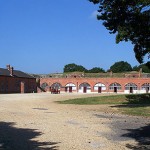
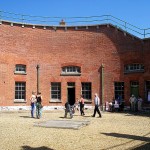
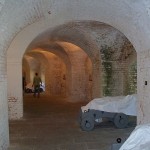
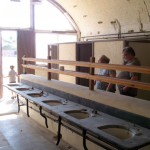
Month: August 2015
M33 – Portsmouth Historic Dockyard
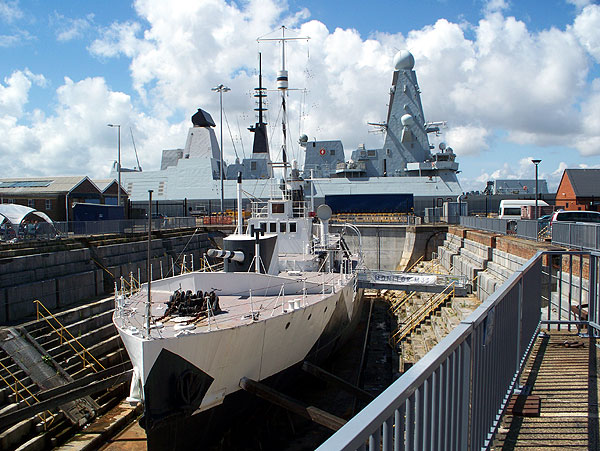
The monitor ship M33 has recently completed a restoration of its interior and was ceremonially opened on the 6th August 2015. Previously one had only been able to view the ship from the top of the drydock.
I was one of the first members of the public allowed on board on the 7th August. The ship was built within around seven weeks as a shore bombardment vessel, and despite mounting two 6 inch guns it has a displacement of only a few hundred tons and no armour.
You may find it interesting to compare this ship with the 10,000 ton cruiser HMS Belfast (C35) which has twelve 6 inch guns.
M33 is one of the very few ships surviving from WWI, and the only survivor of the Gallipoli campaign.
As seen today, the 6″ guns are essentially the same as the originals, and the crew accommodation, stores, officer quarters, galley, wheel house, radio room etc have been fitted out with representative contents. Maxim guns as used for repelling close attack stand on slots in the side deck.
The engines and boilers were removed a long time ago, prior to the ship’s use as a hulk, and have not been replaced. Instead, the space is used as a cinema for a short film. The bass sound in the empty steel space is quite effective. 🙂
The ship is well worth a visit and can be visited as part of the Portsmouth Historic Dockyard. Charges apply.

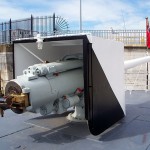
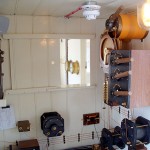
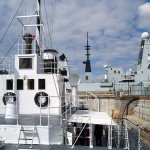
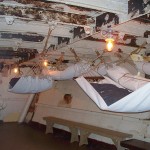
Southsea Castle, Portsmouth
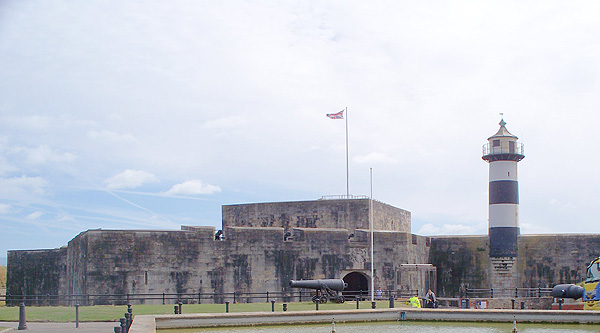 Portsmouth City Council
Portsmouth City Council
The original castle was built in 1544 for Henry VIII, amidst fears of an invasion. It had a square keep and external angular bastions. Subsequently the keep was raised in height, and a much larger set of 19th-century fortifications was built around it, with mountings for 68-pounder guns.
A lighthouse was added to the western gun platform in 1838.
The castle saw active service in WWI and WWII and was still in military use until the 1950’s.
Today, visitors can explore the keep, ramparts and a tunnel that runs under the dry moat. There are several cannon, large and small, on display. Worth a visit.
Admission is free.
A car park (cheargeable) is nearby.
There is a cafe inside the castle.
Thumbnails:
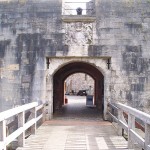
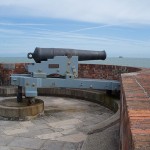
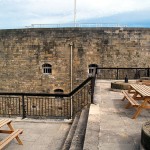
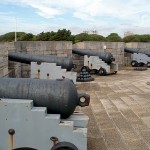
D-Day Museum, Portsmouth
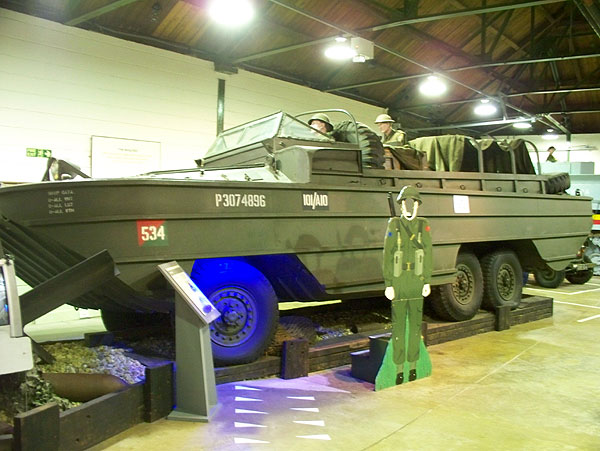 The D-Day Museum is housed in a modern building near the Southsea Castle on the sea-front.
The D-Day Museum is housed in a modern building near the Southsea Castle on the sea-front.
A circular hall has a modern D-Day Tapestry displayed around its circumference, and an auditorium for showing a short 15-minute film in the centre. On the other side of the museum, a winding series of galleries display materials on the build-up to D-Day and the invasion itself. A final pair of halls show vehicles used in the invasion – a glider, jeep, tank, tank landing craft and a DUKW.
It is an interesting museum and worth a visit if you are in the area or if you have a connection with the invasion.
Admission charges apply.
A car park (chargeable) is next to the museum, or you can park along the sea front (chargeable).
The Southsea Castle is about 100 yards away – in fact the D-Day Museum is within the outer defences of the castle.

Westminster – a restoration too far?
I usually write here about visits to heritage sites, but my eye was caught by the quoted costs for refurbishing the Palace of Westminster (Houses of Parliament). The buildings are subsiding and apart from that need general refurbishing of the fabric and an updating of the plant and services. The costs were first quoted as being in excess of £1 billion. Now the estimates span from £2 billion to an eye-watering £7 billion – the latter estimate including delays caused by not moving the MPs out, and likely cost inflation.
Being a member of the National Trust and also English heritage I am normally in favour of preserving old buildings, but spending this much on one project seems a restoration too far.
£7 Bn will be telephone numbers to most people so what could you buy for that?
500 big ticket restoration projects like Windsor £28m, Ightham Mote £11m, Catle Drogo £11m, Uppark £18m
Or £18 million for each one of the 380 properties in this blog.
or: Two large aircraft carriers.
or: A quarter of the HS2 project
or: resolve immediate Greek debt crisis
or: pay off NHS trust debts and re-fund
or: cancel most of proposed £12 billion welfare cuts
Mad, isn’t it?
So what’s there that is really worth preserving?
The medieval Westminster Hall is an amazing and ancient structure that should be preserved. And would be a shame to lose the iconic Gothic exterior of the Houses of Pariament. But the rest of it? Do we really want to spend billions preserving the Victorian interiors? I think not. The House of Commons, demolished by German bombing, dates from the 1940s/50s.
One can’t help reflecting that English Heritage was recently given a private charitable status so that maintenance of ancient monuments, formerly the responsibility of the Government via the Ministry of Works and irs successors, is no longer charged to the public purse. Maybe the same rules should apply to the Palace of Westminster?
At the very least, efforts by MPs to stay in place during the refit, thus increasing the duration of the project and greatly increasing costs, should be resisted.
